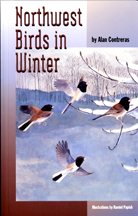Northwest Birds in Winter
Alan L. Contreras
Illustrated by [[Ramiel Papish]].
Observing birds in the Pacific Northwest in winter is both challenging and rewarding. Despite the weather and the fact that many birds are not in their brightest plumage, winter birding is growing increasingly popular. Unlike the breeding season, when many birds are territorial and observers must travel widely to see them, in winter many birds concentrate and a field trip can find amazing densities and species variety in a small area.
Northwest Birds in Winter is the first guide to the distribution and abundance of birds that winter in Oregon, Washington, Idaho, and southern British Columbia. It offers a summary of winter status and distribution information for the nearly 380 regularly occurring species in the region. Detailed winter range maps and 30-year population trend data are provided for many of the species. In addition, the book includes suggestions as to the best winter birding sites in the Pacific Northwest and photographs of the region¹s most unusual winter birds.
This seasonal guide is an essential addition to the literature on Northwest birds and a valuable new resource for birders in the Pacific Northwest.
About the author
ALAN L. CONTRERAS, now retired from a career in higher education, is a writer, editor, and birder. His numerous books include Birds of Oregon: A General Reference and Afield: Forty Years of Birding the American West.
Read more about this author
Introduction and coverage
Winter Birds and Birding
Finding Birds in Winter
Data Sources
The Maps
How to Interpret the Species Accounts
Species Accounts
Gaviiformes
Podicipediformes
Procellariiformes
Pelecaniformes
Ciconiiformes
Anseriformes
Falconiformes
Galliformes
Gruiformes
Charadriiformes
Columbiformes
Psittaciformes
Strigiformes
Apodiformes
Coraciiformes
Piciformes
Passeriformes
Appendix
Literature Cited
Index
This book is intended as a guide to the distribution and abundance of birds that winter in the Pacific Northwest region. I treat as "winter" the months of December, January, and February although some species early December (e.g., southbound Red Phalarope and Bonaparte's Gull) and late February (e.g., northbound Turkey Vulture, waterfowl, Say's Phoebe, Sage Sparrow) involve migration.
For purposes of this book the region is defined as the U.S. states of Oregon, Washington, and Idaho and the southern part of the Canadian Province of British Columbia. Although it would be possible to set boundaries for such a project anywhere that seems appropriate, th region covered by this guide has certain properties that make it particularly appropriate for this project.
First, it contains all of the region between the Rocky Mountains and the Pacific Ocean in northwestern North American except for northern British Columbia, as well as all of the northern Great Basin and almost all of the Columbia-Snake River complex and the Klamath Basin. Al of the major inland valleys that are "northwestern" (as distinguished from "Californian") in vegetative character are also included, with the Rogue Valley of Oregon the principal, widely recognized transition point between these two large natural divisions. Finally, the region contains a long, unbroken expanse of pacific coastline, including virtually all of the major estuaries between Humboldt Bay, California, and the small estuaries of southern Alaska.
These are natural features that belong together for purposes of reviewing the status of wildlife. There are also natural "breaking points" between the region covered and other regions. The expanse of desert separating the basin lakes of southeastern Oregon and the reservoirs of southern Idaho from the Great Salt Lake and water features of Nevada is one such feature. Another is the expanse of forest (with only small valleys) separating the Rogue Valley from the Central Valley of California. The most obvious natural break is the one provided by the Rocky Mountains, which form the eastern boundary of the region.
The only significant outlier that might have been formally included in the book is the Tule Lake-Lower Klamath Lake area just south of the Oregon border. However, the species that winter there are nearly the same as those that winter on the Oregon side of the border, with the exception of the Plain Titmouse, which is more common in California.
Where to draw the line in British Columbia was of course a somewhat arbitrary decision. I decided to include all of the more temperate valleys (especially the Okanagan and coastal valleys) because they are the natural limit of many species in winter, especially those that require open water. The limit of coverage is set at roughly 500 north latitude and, on Vancouver Island, 1260 west longitude. The only exception is that I have tried to include data for the entire Okanagan Valley of British Columbia although the upper part lies above 500. A few records outside the region (e.g. a winter Swainson's Thrush specimen from northern California, a few records for the Queen Charlotte Islands) are mentioned.
The book is not intended to provide a comprehensive listing of records of birds rare in the region such as eiders, eastern warblers, and the like. That information is provided on some occasions when there are very few records for the entire region or when a species' winter range ends abruptly (e.g., Northern Hawk-Owl) and records from adjacent areas help complete the picture of the species' range.

